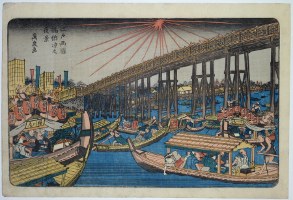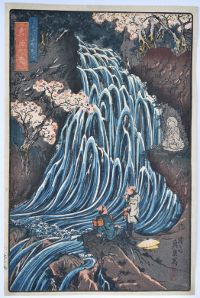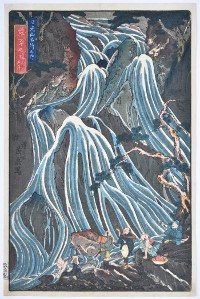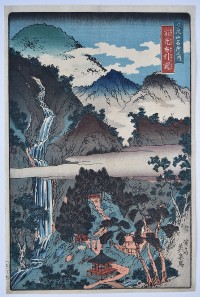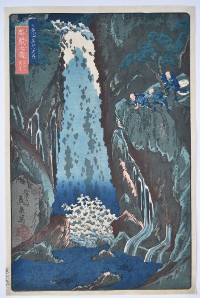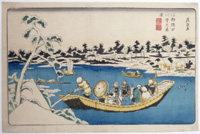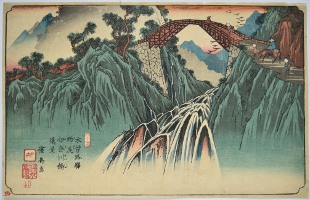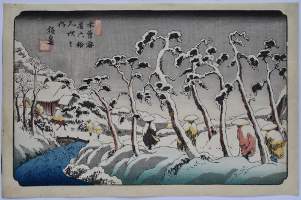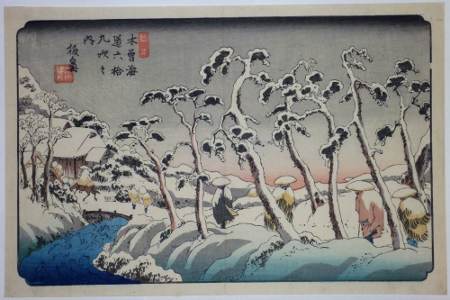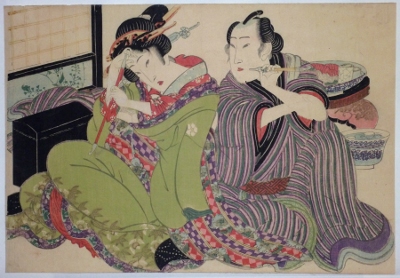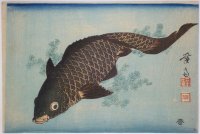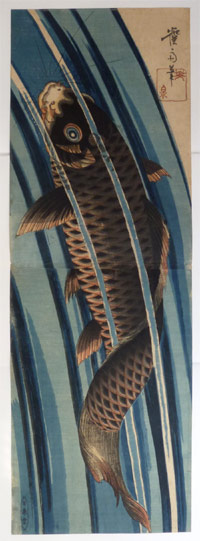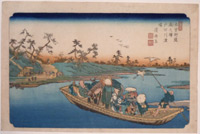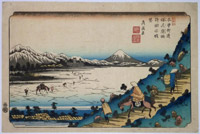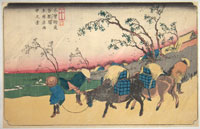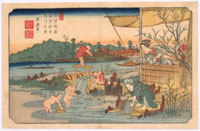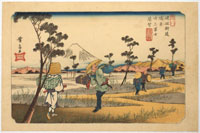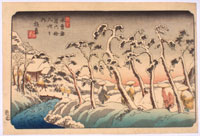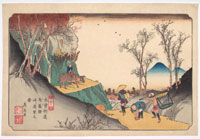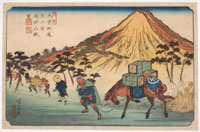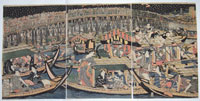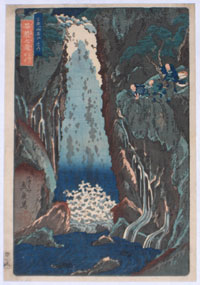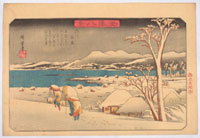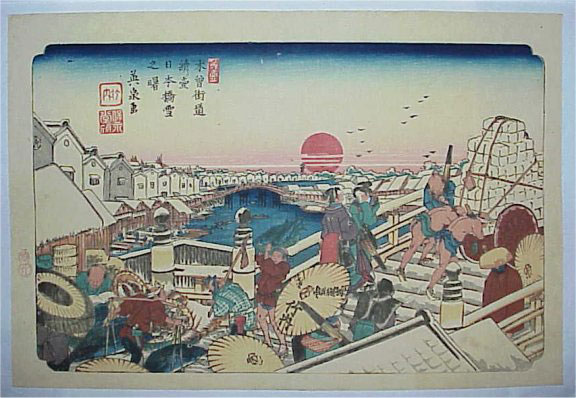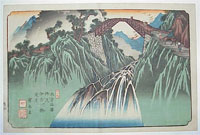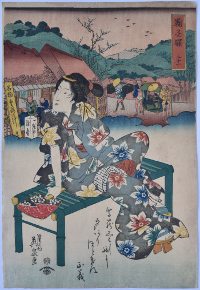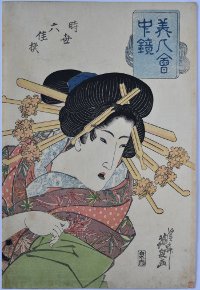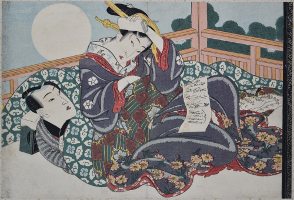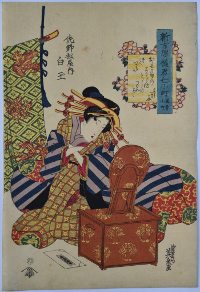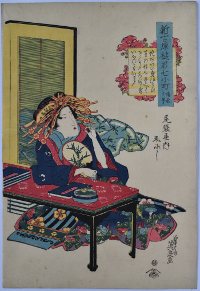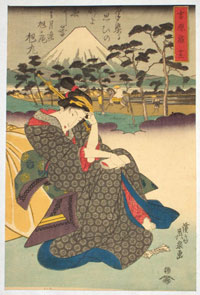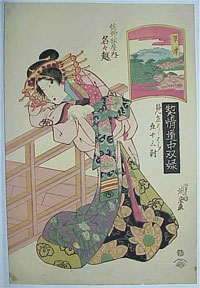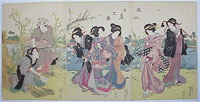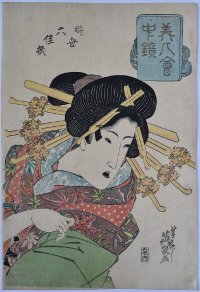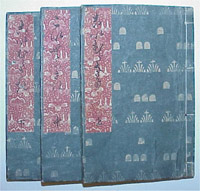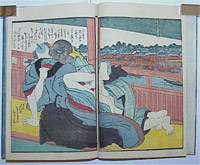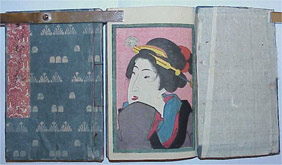Keisai EISEN (1790-1848)
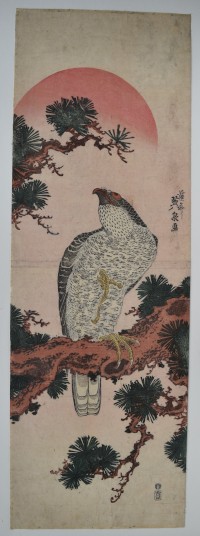
Click here to view image full size.
A vertical double oban showing a falcon on a pine branch with a large red sun above. This was a very popular subject and many artists produced versions in different formats. However, I cannot, at the moment, locate another impression of this design. Published by Kawaguchiya Uhei, c 1830s. Extremely rare.
Fine impression and colour. Slight soil and several expertly repaired wormholes, but otherwise very good condition. Signed Keisai Eisen ga.
Status: Available
Keisai EISEN (1790-1848)
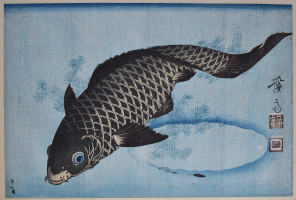
Click here to view image full size.
A carp swimming among water-weed. The moon’s reflection in the blue water. There are various editions of this design: without the moon’s reflection; with and without the censor seal; with and without publisher’s seal; with and without currents in the water. Published by Ezakiya, c. 1843-6. Rare.
Fine impression and colour. Faint vertical folds and two areas of sumi, otherwise very good condition. Signed Keisai with seals Ippitsuan and Keisai.
Status: Available
Keisai EISEN (1790-1848)
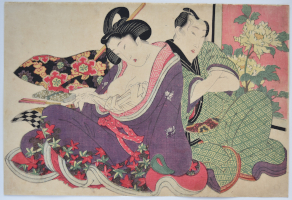
Click here to view image full size.
An amorous couple beside a screen decorated with a large chrysanthemum. From a set of twelve prints Keisei higo, “Secret Words of a Courtesan” published c 1822-25. Although coming under the heading of shunga, each print is an abuna-e design, without any graphic detail. Shows a courtesan with her client. She turns to tie the iwata-sash which indicates she is pregnant.
Fine impression. Very fine colour. Fine condition.
Status: Available
Keisai EISEN (1790-1848)
Click here to view image full size.
Edo Ryogokubashi noryo no yakei, “View of an Evening Cooling Off at the Ryogoku Bridge, Edo.” Shows a multitude of boats beneath the bridge, fireworks above. Published c 1829.
Fine, early impression. Fine colour and condition. Signed Eisen ga.
Status: Sold
Keisai EISEN (1790-1848)
Click here to view image full size.
Although Eisen produced a considerable number of bijin-e and surimono, his best work was in landscape design and amongst these the finest are this set and a few designs for the Kisokaido. Kirifuri-no-taki, santaki no sono ikkei, “Kirifuri Waterfall – View of One of the Three Falls.” From a set Nikkozan meisho no uchi, “Celebrated Views in the Nikko Mountains.” The set of eight prints published by Yamamotoya Heikichi, c. mid 1840s. The set obviously invites comparison with Hokusai’s earlier waterfall set but they are chunkier, more prosaic and with the movement of the water more defined. Shows travellers admiring the fall. A stone Jizo figure on the right (guardian of travellers). Rare.
Fine impression. (There do not appear to be late impressions of this set – presumably it was not popular at the time.) Fine colour. Imperceptible fold, otherwise fine condition. Signed Eisen utsusu.
Status: Sold
Keisai EISEN (1790-1848)
Click here to view image full size.
Although Eisen produced a considerable number of bijin-e and surimono, his best work was in landscape design and amongst these the finest are this set and a few designs for the Kisokaido. Somen-no-taki, “Somen Waterfall.” From a set Nikkozan meisho no uchi, “Celebrated Views in the Nikko Mountains.” The set of eight prints published by Yamamotoya Heikichi, c. mid 1840s. The set obviously invites comparison with Hokusai’s earlier waterfall set but they are chunkier, more prosaic and with the movement of the water more defined. Shows travellers at the base of the fall.
Fine impression. (There do not appear to be late impressions of this set – presumably it was not popular at the time.) Fine colour. Imperceptible fold, otherwise fine condition. Signed Eisen utsusu.
Status: Sold
Keisai EISEN (1790-1848)
Click here to view image full size.
Jakko Nunobiki no taki, “Jakko [Temple] Nunobiki Waterfall” from a set of eight prints Nikkosan meisho no uchi, “Celebrated Views in the Nikko Mountains.” Published by Yamamotoya Heikichi c. 1844. Obviously inspired by Hokusai’s set of waterfalls. See: The Japanese Print: A New Approach, J. Hillier, Bell & Son, 1960, Chapter XVI, where Jack Hillier discusses Eisen and his landscapes and considers this set “… is perhaps the crowning achievement of his career as a designer of landscape-prints.” Extremely rare.
Very fine impression. (I have only seen early impressions of this set – perhaps it was not popular at the time.) Fine colour. Extremely slight vertical fold, otherwise fine condition. Signed Keisai Eisen utsusu.
Status: Sold
Keisai EISEN (1790-1848)
Click here to view image full size.
Kegon no taki, santaki no sono ikkei, “Kegon Falls, One of the Three Waterfalls” from a set of eight prints Nikkosan meisho no uchi, “Celebrated Views in the Nikko Mountains.” Published by Yamamotoya Heikichi c. 1844. Obviously inspired by Hokusai’s set of waterfalls. See: The Japanese Print: A New Approach, J. Hillier, Bell & Son, 1960, Chapter XVI, where Jack Hillier discusses Eisen and his landscapes and considers this set “… is perhaps the crowning achievement of his career as a designer of landscape-prints.” Extremely rare.
Very fine impression. (I have only seen early impressions of this set – perhaps it was not popular at the time.) Fine colour. Extremely slight vertical fold, otherwise fine condition. Signed Keisai Eisen utsusu.
Status: Sold
Keisai EISEN (1790-1848)
Click here to view image full size.
The Sumida River in snow from a series of views of the Koto Ward of Edo. This area was bounded by the Sumida to the west and the Arakawa to the east. Shows travellers being ferried across the river. No publisher or date given.
Very good impression, colour and condition.
Status: Sold
Keisai EISEN (1790-1848)
Click here to view image full size.
The bridge over the Ina River at Nojiri, Nojiri Inagawabashi enkei, from Kisokaido rokujukyutsugi no uchi , “Sixty-Nine Stations of the Kisokaido.” The set of seventy prints was published by Hoeido in 1835, but in 1837 Hiroshige took over and completed the series with the publisher Iseya Rihei (Kinjudo). The conjecture is that Hiroshige was the better known and more commercial artist, reinforced by the fact that Eisen’s name was removed from the designs already published. Hence only the first editions have his signature on those prints. Shows the cascade beneath the bridge, the underside of which resembles Mount Fuji. Top left, just visible in the mist, are the steps leading to the Kiyomizu Temple of Kiso. (Now a world heritage site, famous for the wooden stage jutting out over the mountainside supported by 139 12-meter high keyaki wood pillars.) One of the best designs from the set. Provenance: Ex Grabhorn collection.
Fine impression. Extremely rare in this early printing: There are a number of different states with alternative colouring to the hills, variant gradation below the falls, losing the blue mountains in the distance and without the flight of geese behind the bridge. Only the first edition has the geese, the blue mountains and the Eisen signature (as here). Fine colour. Margins trimmed a little, otherwise very good condition. Signed Keisai ga.
Status: Sold
Keisai EISEN (1764-1824)
Click here to view image full size.
Itahana from Kisokaido rokujukyutsugi no uchi, “Sixty-Nine Stations of the Kisokaido.” The set of seventy prints was started by Eisen and published by Hoeido in 1835, but in 1837 Hiroshige took over and completed the series with the publisher Iseya Rihei (Kinjudo). One of the best designs from the set. This design is never signed, even, as here, on the first edition. Rare.
Fine impression and colour. This is the first edition with gradation on the river and the river bank. Fine condition.
Status: Sold
Keisai EISEN (1790-1848)
Click here to view image full size.
Itahana from Kisokaido rokujukyutsugi no uchi, “Sixty-Nine Stations of the Kisokaido.” The set of seventy prints was started by Eisen and published by Hoeido in 1835, but in 1837 Hiroshige took over and completed the series with the publisher Iseya Rihei (Kinjudo). One of the best designs from the set. This design is never signed, even, as here, on the first edition. Rare.
Fine impression and colour. This is the first edition with gradation on the river and the river bank. Slight centre fold, otherwise fine condition. Ex Pulverer collection and purchased from me in 1974.
Status: Sold
Keisai EISEN (1790-1848)
Click here to view image full size.
A pair of lovers from the set Keisei higo “The Secret Language of Courtesans.” This fine set of abuna-e (shunga prints that omit any explicit sex – quite literally “risky pictures”) was privately published c 1822-5. The pre-coital coupling is indicated by the wad of tissue slipped into her obi.
Fine impression and colour. Very good condition. This set employs brass into the printing which is often the cause of the paper degrading and falling out. (Not evident here.) Unsigned as always.
Status: Sold
Keisai EISEN ( 1790-1848 )
Click here to view image full size.
A prolific pupil of Eizan. Shows a carp swimming among water-weed. Blue ground. An extremely rare print. Published by Ezakiya, c 1843-6. There is another version of this print without censor’s seal and with a moon reflected in the water. This appears to be a copy of the impression offered here as the blocks vary slightly. Ex Vever collection, Sothebys 1977, Part III, lot 227, p. 120 ( who also sold the copy, lot 228 ).
Fine impression, colour and condition. Signed Keisai.
Status: Sold
Keisai EISEN (1790-1848)
Click here to view image full size.
A vertical diptych of a carp leaping a waterfall. Published by Kansendo, c 1830 – 44. Illustrated Keisai Eisen: Artist of the Floating World, Chiba City Museum of Art, 2012, p. 240, pl. 313.
Very good impression, colour and condition. This was a popular design and later impressions are common. Signed Keisai hitsu with large red artist’s seal Eisen.
Status: Sold
Keisai EISEN (1790-1848)
Click here to view image full size.
Warabi, one of the Stations from Kisokaido rokujukyutsugi no uchi, “Sixty-Nine Stations of the Kisokaido.” The set of seventy prints was started by Eisen and published by Hoeido in 1835, but in 1837 Hiroshige took over and completed the set with the publisher Iseya Rihei ( Kinjudo ). Warabi no eki Todagawa watashi, “Warabi Station, Ferry on the Toda River.” Shows a ferry with a group of travellers: a pair of goze ( blind singers ); three males with hats; a horse and handler, and a porter smoking in the prow. The Station is seen on the far shore.
Very fine impression of the first edition with signature. Fine colour and condition. Signed Eisen ga.
Status: Sold
Keisai EISEN (1790-1848)
Click here to view image full size.
Shiojiri Pass, View of Lake Suwa, from the Sixty-Nine Stations of the Kisokaido. The set was started by Eisen and published by Hoeido in 1835, but in 1837 Hiroshige took over and completed the series with the publisher Iseiri ( Kinjudo ). A view from the pass over the frozen lake towards Takashima Castle, with Mount Fuji in the distance. A short cut over the ice was available in the winter mornings after the ice had frozen during the night. This is the earliest state. Extremely rare.
Very fine early impression. The first state of a number of variants with Take [ nouchi Magohachi ] on the girth of the horse; signature and seals, and gradation on the banks on the right of the print. Combined Take and kiwame seal in left margin. Signed Eisen ga.
Status: Sold
Keisai EISEN (1790-1848)
Click here to view image full size.
Kutsukake no eki Hiratsukahara uchu no kei, ” Kutsukake Station, Rain on the Nearby Plain of Hiratsuka” from the Sixty-nine Stations of the Kisokaido. The set was started by Eisen and published by Hoeido in 1835, but in 1837 Hiroshige took over and completed the series with the publisher Iseiri ( Kinjudo ). A windy autumnal squall over the Hiratsuka flood plain. One of the best Eisen designs from the set. Known in various states and colour variations. The very rare first edition has the signature lower right corner.
Very good impression. Fine colour. Very good condition. Unsigned.
Status: Sold
Keisai EISEN (1790-1848)
Click here to view image full size.
Kuragano Station, Karasu River, Kuragano shuku Karasugawa no zu from the Sixty-nine Stations of the Kisokaido. The set was started by Eisen and published by Hoeido in 1835, but in 1837 Hiroshige took over and completed the series with the publisher Iseiri ( Kinjudo ). Situated at the confluence of three rivers, the Tone, Karasu and Kabura. In spring a ferry service was available down to Edo. The station can be seen on the far shore. Small children play in the foreground watched by a lady taking tea at a rest-stop. This appears to be the earliest state known of this design – earlier than the first edition example illustrated in the NHK exhibition catalogue, Hiroshige: Tokaido and Kisokaido, 2006, pl. 14, p. 43, with greater subtlety in the printing and gradation on the river.
Very fine impression of the first edition. Fine colour. Slight centre fold, otherwise very good condition. Signed Eisen ga.
Status: Sold
Keisai EISEN (1790-1848)
Click here to view image full size.
Konosu from the Sixty-nine Stations of the Kisokaido. The set was started by Eisen and published by Hoeido in 1835, but in 1837 Hiroshige took over and completed the series with the publisher Iseiri ( Kinjudo ). Shows travellers on a zig-zag path that disappears into a range of mountains on the right. To the left, a large Fuji towers over the landscape. The very rare first edition with signature – which is lacking on later states – and differences in colour and gradation. The removal of the signature was presumably because the publishers wanted the public to think the designs were by Hiroshige , the better known landscape artist of the two.
Very fine impression and colour. Extremely large margins. Fine condition. Signed Eisen ga.
Status: Sold
Keisai EISEN (1790-1848)
Click here to view image full size.
Itahana from the Sixty-nine Stations of the Kisikaido. The set was started by Eisen and published by Hoeido in 1835, but in 1837 Hiroshige took over and completed the series with the publisher Iseiri ( Kinjudo ). Shows the entrance to the village with well-wrapped travelers trudging through the snow along a road edged with pines. The sun has set on the horizon. The rare first edition: Other designs from the set are signed on the first edition, but this is the exception. In later editions the red seal, top left, changes; the water in the stream, left, is graded above, not below; the hand-stamped kiwame/Take seal in left margin is left off, and the blue printed on the first figure’s legs and the legs of the two small figures on the bridge is lacking. ( See Ukiyoe Taikei, vol.15, no.15 for an example of the later edition. )
Very fine impression and colour. Two small thin areas right margin and several backed pin holes near border, otherwise fine condition. Unsigned.
Status: Sold
Keisai EISEN (1790-1848)
Click here to view image full size.
Magome from the Sixty-nine Stations of the Kisokaido. The set was started by Eisen and published by Hoeido in 1835, but in 1837 Hiroshige took over and completed the series with the publisher Iseiri ( Kinjudo ).
Fine impression. A rare variant first edition with signature but without the large central mountain. Not listed by Strange. There are later editions without signature and with and without central mountain. Fine colour and condition. Signed Keisai ga.
Status: Sold
Keisai EISEN (1790-1848)
Click here to view image full size.
Oiwake from the Sixty-nine Stations of the Kisokaido. The set was started by Eisen and published by Hoeido in 1835, but in 1837 Hiroshige took over and completed the series with the publisher Iseiri ( Kinjudo ). In the distance is Asama-yama, Mount Asama, a volcano which erupted in 1783. It also emitted debris in 1894 and 1900. This is the extremely rare first edition with signature Keisai and seal bottom left. ( Not in Ukiyo-e Taikei .) Unidentified collector’s seal au verso.
Fine impression and colour. Minor edge soil, otherwise very good condition. Signed Keisai ga.
Status: Sold
Keisai EISEN (1790-1848)
Click here to view image full size.
A rare triptych showing a multitude of pleasure boats enjoying the cool of the evening on the Sumidagawa. Ryogoku Bridge in the background and exploding rockets above. This was a subject that inspired numerous artists and depicts the essence of ukiyoe. No doubt the public were meant to identify some of the figures in the foreground vessels. Published c late 1820s. Publisher Yamashiroya Shojiro Yasuko.
Very good impression and colour with the fugitive blue and purple intact. Slight soil on centre sheet otherwise very good condition: Full size with extra paper all round. Signed Keisai Eisen ga.
Status: sold
Keisai EISEN (1790-1848)
Click here to view image full size.
The Kegon Waterfall from the set: Celebrated Views in the Nikko Mountains published by Yamamoto, c 1844. The set obviously inspired by Hokusai’s earlier waterfall set of eight prints, but impressions are rarer indicating it may not have been so popular.
Very good impression and colour. Slight soil around edges and thinned area in top margin. Signed Keisai Eisen utsusu.
Status: Sold
Ichiryusai HIROSHIGE (1797-1858)
Click here to view image full size.
‘Evening Snow at Uchikawa’, Uchikawa bosetsu from the early set Kanazawa hakkei, ‘Eight Views in Kanazawa’ published by Koshimuraya Heisuke, c 1835-6. This is an extremely rare and fine set and examples in good condition are very difficult to find. 31-syllable waka poem above. One of Hiroshige’s finest compositions.
Fine impression, colour and condition with large margins. Signed Hiroshige ga.
Status: sold
Keisai EISEN (1790-1848)
Click here to view image full size.
Early morning snow on Nihonbashi. The first design from Kisokaido rokujukyu-tsugi, “The Sixty-Nine Stations of the Kiso Highway” published c1836 by Takeuchi and Hoeido. The extremely rare first edition with rising sun, publisher’s name on umbrella and signature: There are at least three later states of this design.
Superb impression and colour. One very small backed wormhole, otherwise very fine condition with extra large margins and complete seal at left. Signed Eisen ga.
Status: Sold
Keisai EISEN (1790-1848)
Click here to view image full size.
The Ina River Bridge, Nojiri from the series Kisokaido rokujukyu-tsugi, “The Sixty-Nine Stations of the Kiso Highway”, published c.1836 by Takeuchi and Hoeido. Extremely rare first state of first edition of this fine design: Only the earliest edition has the geese above and beneath the bridge, the extra peaks in the same area and to the far top left. Also the signature is only found on earliest state. See Lane, Images from the Floating World, no.194 (A-B), p.190.
Very good impression and colour. Very slight centrefold otherwise good condition. Signed Keisai ga.
Status: Sold
Keisai EISEN (1790-1848)
Click here to view image full size.
Mariko, Station 21, from the Bijin Tokaido which compares beauties to the Fifty-three Stations of the Tokaido. This Station was famous for tororojiru, a dish of yams and white bean paste. An inn behind is advertising this meal.The set was published by Tsutaya, c early 1830s but only 40 designs are known as the government considered them a little risqué. The set was reissued without the Station numbers and censor seal for 1846.
Fine impression and colour. Nice oxidation. Very good condition. Full size. Signed Keisai Eisen ga.
Status: Sold
Keisai EISEN (1790-1848)
Click here to view image full size.
A high-ranking courtesan ( oiran ) looking over her shoulder. From a set of six prints: Bijin kaichu kagami – Jisei rokkassen: Ariwara no Narihira, “ A Pocket Mirror of Beauties – Six Immortal Poets of the Era: Ariwara no Narihira.” The set compares the beauties to the six “immortal” waka poets of the 9th/10th centuries. The maple leaves on the oiran’s collar identify the subject as compared to the poet Ariwara no Narihira ( 825-880 A.D. ). The set published by Senichi, c 1826-28.
Fine early impression. Fine colour. Very slight soil and trimming bottom right, otherwise fine condition. Signed Keisai Eisen ga.
Status: Sold
Keisai EISEN (1790-1848)
Click here to view image full size.
An amorous couple on a balcony with a large full moon. One of the three best designs from a set of twelve prints: Keisei higo, “Secret Words of a Courtesan” published c 1822-25. Although the set comes under the shunga heading, each print is an abuna-e design, without any graphic detail. Fine composition.
Fine impression and colour. Laid onto board from the original album. Small wormage and slight centre fold ( as usual ), otherwise good condition.
Status: Sold
Keisai EISEN (1790-1848)
Click here to view image full size.
The courtesan Shiratama of the Sanomatsuya House in the Shin Yoshiwara seated looking into a mirror. Episode Sekidera from a Seven Komachi set: Shin Yoshiwara yugimi nana Komachi. The set based on the seven episodes in the life of the famous 9th century poetess Ono no Komachi. Published by Tsuta-ya, c 1830.
Very good impression of the first state. Superb, unfaded colour. Fine condition; full size. Signed Kei
Status: Sold
Keisai EISEN (1790-1848)
Click here to view image full size.
The courtesan Efuku of the Owariya House in the Shin Yoshiwara seated at a low desk and holding a toothpick. Episode Kiyomidzu from a Seven Komachi set: Shin Yoshiwara yugimi nana Komachi. The set based on the seven episodes in the life of the famous 9th century poetess Ono no Komachi. Published by Tsuta-ya, c 1830.
Very good impression of the first state. Superb, unfaded colour. Fine condition; full size. Signed Keisai Eisen ga.
Status: Sold
Keisai Eisen (1790-1848)
Click here to view image full size.
Yoshiwara from the set: “Bijin Tokaido” comparing beauties to the 53 Stations. Published by Tsutaya c 1830’s. A fine design.
Very fine impression, colour and, apart from minor trimming, fine condition. Signed Keisai Eisen ga
Status: Sold
Keisai EISEN (1790-1848)
Click here to view image full size.
The courtesan Nanakoshi of Sano Matsu-ya. Station Kusatsu from a series parodying Yoshiwara courtesans with the 53 Stations of the Tokaido; the set seen as a sugoroku game, the winner gaining the lover. The set published by Tsutaya Kichizo, c late 1830s.
Fine impression and colour. Small stain lower left corner and minor marks, but otherwise very good condition. Signed Keisai Eisen ga.
Status: Sold
Keisai EISEN (1790-1848)
Click here to view image full size.
A triptych entitled Fuzoku shi-nho-ko sho, “The Customs of Different Classes, Samurai, Farmers, Artisans and Tradesmen”. Published by Kawaguchiya Uhei c.1820s.
Very good impression, perfect colour. Original album backing. Fine condition. Signed Keisai Eisen ga.
Status: Sold
Keisai EISEN (1790-1848)
Click here to view image full size.
A high-ranking courtesan ( oiran ) looking over her shoulder. From a set of six prints: Bijin kaichu kagami – Jisei rokkassen: Ariwara no Narihira, “ A Pocket Mirror of Beauties – Six Immortal Poets of the Era: Ariwara no Narihira.” The set compares the beauties to the six “immortal” waka poets of the 9th/10th centuries. The maple leaves on the oiran’s collar identify the subject as compared to the poet Ariwara no Narihira ( 825-880 A.D. ). The set published by Senichi, c 1826-28.
Fine early impression. Fine colour. Very slight soil, otherwise fine condition. Full size. Signed Keisai Eisen ga.
Status: Sold
Keisai EISEN (1790-1848)
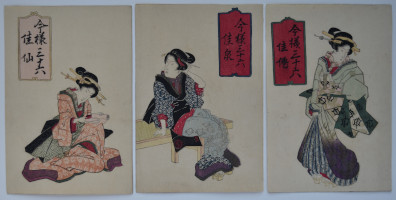
Click here to view image full size.
Three koban surimono-style prints from a set Imayo sanjurokkasen, “Thirty-six Selected Pictures.” Published c late 1820s.
Fine impressions, colour and condition.
Status: Sold
Keisai EISEN (1790-1848)
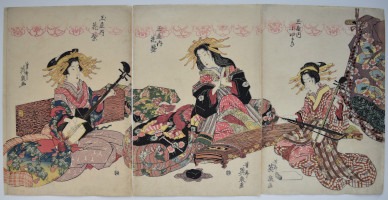
Click here to view image full size.
A triptych showing three courtesans from the Tamaya House: On first sheet Koyuki playing the kokyu; on the second Hanamurasaki playing the koto; and on the third Hanakazura playing the shamisen. Published c 1830.
Fine impression with excellent colour. Some expert edge restoration, otherwise very good condition with extra paper around.
Status: Sold
Unsigned Shunga (Attributed to Keisai EISEN)
Click here to view image full size.
Three volumes complete. Koi murasaki, “Purple Love”. Original covers and title slips. Published circa early 1840s.
Very fine impressions and colour, one wormhole on one volume, otherwise very good condition throughout.
Status: Sold
